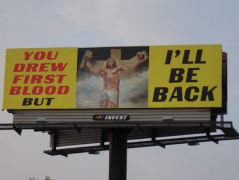
And His glory will inevitably be veiled and distorted by our best renderings. Even strength depicted fails His omnipotence. All our fallen images trivialize the majesty of His might. One fella is even having a little fun by running a caption contest for this billboard.

Here's how J.I. Packer commented in Knowing God (pp. 45-46) on the use of images:
The likeness of things in heaven (sun, moon, stars), and in earth (people, animals, birds, insects), and in the sea (fish, mammals, crustaceans), is precisely not a likeness of their Creator. "A true image of God," wrote Calvin, "is not to be found in all the world; and hence... His glory is defiled, and His truth corrupted by the lie, whenever He is set before our eyes in a visible form.... Therefore, to devise any image of God is itself impious; because by this corruption His majesty is adulterated, and He is figured to be other than He is."The point here is not just that an image represents God as having a body and parts, whereas in reality he has neither. If this were the only ground of objection to images, representations of Christ would be blameless. But the point really goes much deeper. The heart of the objection to pictures and images is that they inevitably conceal most, if not all, of the truth about the personal nature and character of the divine Being whom they represent.
To illustrate: Aaron made a golden calf (that is, a bull-image). It was meant as a visible symbol of Jehovah, the mighty God who had brought Israel out of Egypt. No doubt the image was thought to honor him, as being a fitting symbol of his great strength. But it is not hard to see that such a symbol in fact insults him, for what idea of his moral character, his righteousness, goodness and patience could one gather from looking at a statue of him as a bull? Thus Aaron's image hid Jehovah's glory.
In a similar way, the pathos of the crucifix obscures the glory of Christ, for it hides the fact of his deity, his victory on the cross, and his present kingdom. It displays his human weakness, but it conceals his divine strength; it depicts the reality of his pain, but keeps out of our sight the reality of his joy and his power. In both these cases, the symbol is unworthy of most of all because of what it fails to display. And so are all other visible representations of deity.
Whatever we may think of religious art from a cultural standpoint, we should not look to pictures of God to show us his glory and move us to worship; for his glory is precisely what such pictures can never show us. And this is why God added to the second commandment a reference to himself as "jealous" to avenge himself on those who disobey him: for God's "jealousy" in the Bible is his zeal to maintain his own glory, which is jeopardized when images are used in worship.
In Isaiah 40:18, after vividly declaring God's immeasurable greatness, the Scripture asks us: "To whom, then, will you compare God? What image will you compare to him?" The question does not expect an answer, only a chastened silence. Its purpose is to remind us that it is as absurd as it is impious to think that an image modeled, as images must be, upon some creature could be an acceptable likeness of the Creator.
Which leads to a related question: is it permissible for actors to portray Jesus in Christian movies and stage plays? One example is the movie, The Gospel of John, a word for word, dramatic presentation of the Gospel of John.
ReplyDeleteAh, but images are inevitable. Jesus used hundreds of them. He knew it was inevitable that when he said, "I am the bread of life," we'd imagine that. "I am vine, you are the branches." We're SUPPOSED to imagine that. It's why John paints such a clear picture in Revelation 1. To spur our imaginations.
ReplyDeleteNow, of course ALL images fall short. That's why we're not supposed to make graven ones: It locks him into one image, when he is neither the image nor the total of what it represents. But to refuse to imagine God or allow scripture to evoke the images it gives us is to abstract God into propositions and statements, which is far worse. At least a picture, while inadequate, is worth a thousand words.
The beauty of imagination is that it is not static (graven); it adapts, it shifts, it changes, enlarges as new information requires it. My mind is captured by the images of God scripture feeds me, but is always open to more accurate viewpoints that improve those images in my mind.
Remember that words are symbols themselves, designed to represent real things. They do that whether we want them to or not.
Red ball.
You just "Saw" a red ball in your mind, right? :)
I think Packer is misguided here, even though he means well.
Thanks so much for this blog entry. I agree, but do not hear much about it. It is a principle, but pragmatically current practise of trying to picture God seems to be a hindrance to evangelism to Muslims.
ReplyDelete